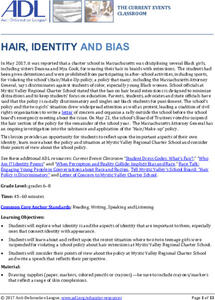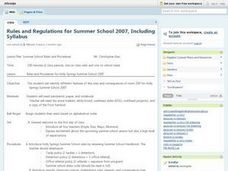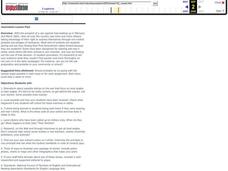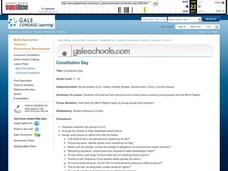Anti-Defamation League
Student Dress Codes: What's Fair?
The controversy over school dress codes continues. The debate involves questions like, why is there a policy? Who sets the policy? Who enforces the policy? What is a fair policy? Tweens and teens have an opportunity to engage in the...
Curated OER
Finding the dress code balance
Students write a persuasive essay, expressing their opinions of how the school dress code should be changed. Students investigate their own school's dress code, developing their own opinions of whether the dress code should be more or...
Anti-Defamation League
Hair, Identity and Bias
Middle schoolers weigh in on dress codes, specifically those that apply to hair and make-up, with a lesson that uses a 2017 case from a charter school in Massachusetts. Class members read about two girls suspended for violating the...
Curated OER
Does My Hair Disrupt Your Learning
Pupils research the laws and policies for school dress codes in their school and others in their state or area and explore what others say about these policies. After research is complete, students divide into two teams to develop...
Curated OER
Who Needs a Dress Code?
Students create a poster showing examples of appropriate and inappropriate student grooming and attire. They write comments explaining the need for each rule.
Curated OER
School Uniforms
Students view various aspects of peer pressure and their complications. Students define the issues of uniform rules and design a uniform for their teachers. Students develop ideas for dress codes.
Curated OER
Summer School Rules and Procedures
Students examine the rules and procedures involved for taking summer school. They determine the consequences and rewards surrounding the compliance or non compliance with school expectations. The features of rules and expectations are...
Curated OER
Uniforms vs. Fashion: Want to Take a Side?
Seventh graders write a draft of a persuasive essay to the principal addressing the issue of whether or not Three Oaks Middle School should adopt uniforms. This lesson get your students motivated to try persuasive writing!
Curated OER
Forced To Wear a Skirt
Students examine the issues surrounding the use of school uniforms. They look at appropriate school attire as opposed to the appropriate. They read a School Uniform Report and discuss it. They participate in a role play activity as a...
Curated OER
Would You Like to Attend School in Japan?
Sixth graders construct pro and con T-charts about their education system and that of Japan. They choose which system they prefer and give five reasons for it. Their reasons must be based on strong arguments and evidence.
Curated OER
Speaking Out Against War
Students discuss the affect the Iraq War has had on citizens taking advantage of their right to express themselves through non-violent protests and pledges of resistance. They research and discuss local community and school events and...
Curated OER
You Forgot Your Skirt, Amelia Bloomer!
Young scholars study women's clothing in the 19th century as well as one prominent
feminist of the time. They examine women's dress of the period from the picture book read aloud You Forgot Your Skirt, Amelia Bloomer! They provide...
Curated OER
Democratic Process, Constitutional Issues, Local Government
Twelfth graders engage in the decision making process so as to encourage them to become active citizens upon graduation from high school.
Curated OER
Federalist 47
Students will analyze and evaluate political propaganda. In this lesson on the Federalist movement, students will examine the Federalist papers and analyze the Anti-Federalist argument mage against constitutional ratification. This...
Curated OER
Political Spectrum
In this political spectrum worksheet, students view a PowerPoint presentation and respond to 11 short answer questions about political terms. The presentation is not included.
Curated OER
Take Your Students Behind the Veil
Students consider race relations in Britain. In this current events lesson, students visit selected websites to understand religious dress, Muslim practices, and the crisis regarding multiculturalism in Britain.
Curated OER
The Roots of Our Rights
Students examine the Preamble to the Constitution. For this government lesson, students read the Preamble of the Constitution and define the meaning of unknown words. Students write about examples of how the Constitution protects our...
Curated OER
The Influence of Media on Decision Making: Exploring Ideas of Bias in Media with a Committee of the Legislative Assembly
Eleventh graders participate in a role play about the Legislative Assembly of British Columbia. They write an essay evaluating the influence (if any) the media has on decision-making.
Curated OER
Cultural Comparisons Interview
Students interview a family member and give an oral report. In this oral history lesson, students create interview questions relevant to an American historical period. Students interview a family member and present an oral report to the...
Curated OER
Constitution Day
Students examine and discuss recent court cases involving young people and the Bill of Rights.They use a focus question to create the context for class discussion: How does the Bill of Rights apply to young people and students?
Curated OER
It's a Wrap!
Learners study two-dimensional and three-dimensional objects by assembling a sculptural piece from something very flat - pieces of newspaper or wallpaper. They see what materials people used to make clothing during the depression.






















